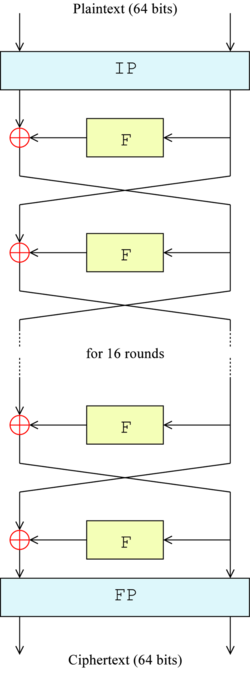DES
- This is more of a case study.
- But everyone should understand what is going on here.
- DES : Data Encryption Standard
- Developed under the guidance of the US Government.
- Data is encrypted with a 56 bit key
- Data is processed in 64 bit blocks
- Using only bitwise and basic arithmetic operations.
- Substitution and Transportation
- Substitution: The character's value is changed while the position remains the same.
- Transportation: The character's position is changed, while the value remains the same.
- Each of these is performed over and over again
- In DES 16 cycles.
-

- It takes turns mixing the bits and changing the bits with a given key.
- It is reversible.
- A Brief Timeline
- 1973 Development begins
- 1977 Standard published.
- 1998+ Brute force custom machines break code in days.
- 2004 DES withdrawn as a standard.
- 2016 - Brute force system with GPU hardware in 2 days
- The algorithm is fixed at a 56-bit key
- So extending the key changes the algorithm.
- Therefore people looked at other ways to enhance the algorithm.
- Double DES
- Use two 56-bit keys and encrypt twice.
- E($K_2$, E($E_1$,P))
- This turns out to only be slightly better than the basic.
- IE The key becomes a 57 bit key.
- Triple DES
- E($K_1$, D($K_2$, E($K_1$,P))) is equivalent to a 80 bit key.
- E($K_3$,E($K_2$, E($E_1$,P))) is equivalent to a 112 bit key
- These are more secure.
- There have been problems with DES all along.
- The Government sponsored the development.
- The NSA stepped in and changed the proposed standard
- There is a general belief that they weekend it to make it easier to crack.
- Moore's law has degraded it over time.
- Custom hardware has weekend it.
